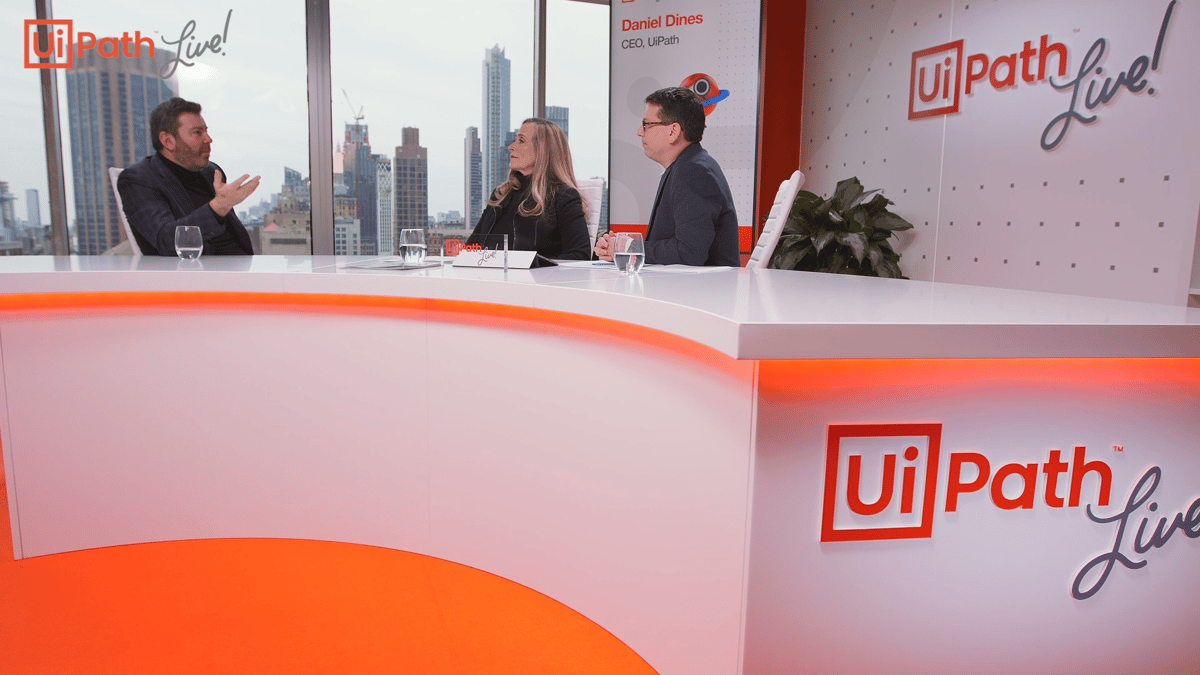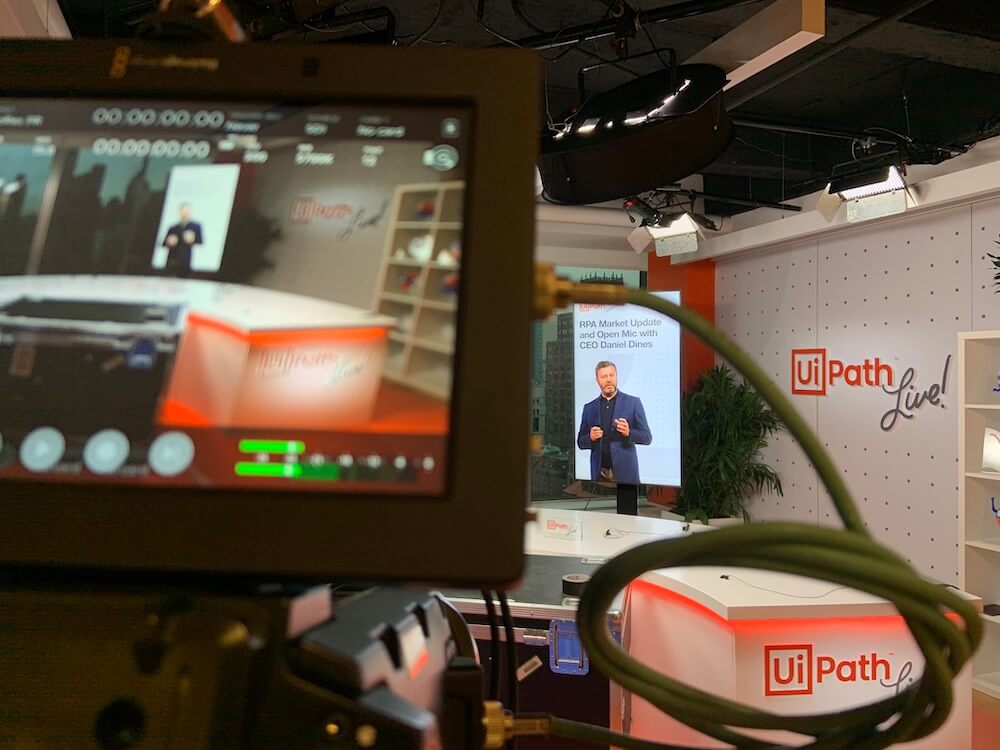The Best of CEO Daniel Dines Unscripted from UiPath Live
Share at:

Bobby Patrick is chief marketing officer (CMO) at UiPath.
It’s not every day you get to pick the brain of the founder of the fastest-growing enterprise software company around. Recently, we had the opportunity to share an open, unscripted conversation with Daniel Dines, UiPath founder and CEO, during the UiPath Live broadcast event on February 20, 2020. Daniel answered audience questions, covering topics that ranged from market growth to advice for tech entrepreneurs.

It is well worth the watch—you can watch the replay or read the full transcript—but I’ve summarized the best points from Daniel’s unscripted open mic for you here.
Advice for tech entrepreneurs, RPA developers, and businesses
Before Daniel was the automation expert we know today, he was an entrepreneur and a developer. His early days as the founder of UiPath resulted in a lot of lessons about the automation market and building a unicorn company.
For tech entrepreneurs, he shared some timely advice and what he wishes he’d known at the start. For Robotic Process Automation (RPA) developers today, he touched on what the future of RPA careers looks like and how people in these pivotal roles can continue to evolve alongside the market.
How to succeed today as a tech entrepreneur
“The defining moment was when we turned from a technology company into a kind of customer-first company,” Daniel told our Live event audience, when asked about the turning point in the UiPath success story. He went on to urge entrepreneurs, especially those with a technical or engineering background, to adopt a customer-first mindset.
For Daniel, adopting this mindset at UiPath unveiled the following three key principles:
1. Listen to your customers. When you listen to your customers, you will naturally build a great product.
2. Let competitors focus on you while you focus on your end user. Don’t let competitors and their tactics distract you. Focus your energy on your customers, and that focus will naturally become your competitive advantage.
3. Embrace humility. Adaptability is everything for startups, and humility is what allows you to be responsive to reality. “Humility gives you the opportunity to course-correct fast,” Daniel said. “I think this is the most important business lesson that I ever had in my life.”
No matter how technical your product, creating a customer-centric business model ensures you’re well positioned in the market by keeping your end users front-of-mind at each stage of your evolution.
How to future-proof your career as an RPA developer
Daniel also had some important advice for RPA developers. In this rapidly evolving world of automation, he says it’s pivotal to expand your knowledge horizontally to interrelated technologies.
Knowledge of all the core technologies of automation is invaluable for today’s RPA developers. An understanding of process mining, task mining, analytics, a bit of artificial intelligence (AI), and a bit of machine learning (ML) create a well-rounded, agile skillset for any career.
Daniel suggested UiPath AI Fabric as an ideal place to practice with these technologies. AI Fabric comes with predefined models, so developers can work with customers and experience the instant gratification of increasing performance. The UiPath Academy also provides a great starting place for expanding your knowledge of the larger automation ecosystem.

Before UiPath Live, behind the scenes
The state of the automation market
A recent report predicted that the total available market (TAM) for RPA could be as large as $30 billion (and some believe even that might even be on the conservative side). When we consider how that TAM is evolving, it’s fair to ask: what has gotten us here, and what will make that TAM bigger as we move into the future? Daniel cited three broad trends as being the drivers for this market growth:
1. The availability and end-user viability of AI. “If one of these platforms will become the de facto platform for building all enterprise applications, [AI] might be it,” he said. As low-code, no-code, and business application platforms become more widely available to end users and citizen developers, we’ll see continued expansion in the market.
2. The evolution of automation user interfaces as the new APIs. As people gain a better understanding of what is possible through automation, Daniel predicts that people will come to realize that automation can consume other applications to streamline the user experience. He predicts that developers will start to introduce user interface (UI) versioning in the same way automation has historically used API versioning.
3. Increasing market acceptance of RPA and automation in general. According to a recent report by The Economist Intelligence Unit, 91% of organizations are already using automation technologies in some form. Sixty-nine percent consider software automation a high or essential priority. We expect these numbers to continue climbing as RPA becomes more of an enterprise imperative in the coming years.
The TAM growth around these trends will bring new players to the automation market, with Microsoft being the most recent notable announcement. But for Daniel, it’s not intimidating to see such a big player make a bid to create UI automation. “It’s flattering for me and us personally,” he said. “It’s a great validation of the space.”
The partnership between RPA and AI
AI has been a popular buzzword in the automation community, and it’s caused some confusion about how AI technology fits into the broader automation market and tool stack.
The truth is, AI has always been a part of automation. Since the beginning, AI has powered RPA through tools like computer vision, which can detect and interact with objects on the computer screen.
However, integrating AI into every single thing you do should not be the end goal in and of itself. “AI is a set of technologies that power other products that, in the end, serve as a business tool,” Daniel said.
He challenged developers to consider what they want to achieve with AI, instead of simply building AI for the sake of AI.
AI is an important part of the hyperautomation ecosystem, but at the end of the day, it’s only one part of a greater equation.
Related read: Are You Ready for Hyperautomation?
Process mining and what it means for the future of automation
Process mining is one of the most important recent developments in automation. It allows for the continuous improvement of workflows, fueling the forward momentum of your automation machine.
One of the main barriers to a successful RPA program, Daniel said, is figuring out which processes can and should be automated and how best to automate those processes. The combination of process mining with automation technology breaks this barrier down.
We made a significant investment in this technology in 2019 with the acquisition of ProcessGold to bring together process mining and automation capabilities. It’s no longer uncommon to see humans working in tandem with robots to develop RPA workers to solve problems that were identified by process mining automations.
By integrating process mining and task mining with RPA and AI, we have essentially begun to automate the task of automation itself.
Daniel’s take on what makes UiPath unique
More than one Live audience member asked about UiPath and the UiPath competitive advantages.
UiPath has always been focused on creating the best product possible. But we’ve made moves in the last five years to hone in on what it means to be customer-centric amid rapid growth and innovation.
As a result, UiPath was able to build the best computer vision on the market—AI Computer Vision. This translated into success when we integrated top-notch technology with a commitment to listening to our customers.
As Daniel shared, the shift in focus has paid off. UiPath consistently ranks as a leader in the automation market. In 2019 alone, UiPath was ranked as a leader in analyst reports including The Forrester Wave™: Robotic Process Automation, Q4 2019 report and the 2019 Gartner Magic Quadrant for Robotic Process Automation Software.
Daniel attributes this success to 50% faster implementation and lower maintenance costs—the product of our marriage of technology and customer service.
As we move into the future, we’re focused on building the best possible product and using that platform to serve our customers’ evolving needs. We’re constantly adapting to make the UiPath Enterprise RPA Platform, our customer service, and our company culture the best it can be.
If you missed our first UiPath Live event, make sure to catch up with the on-demand recording of RPA Market Update and Open Mic with Daniel Dines to find out more about the automation market today.

(Previously) Chief Marketing Officer, UiPath
Get articles from automation experts in your inbox
SubscribeGet articles from automation experts in your inbox
Sign up today and we'll email you the newest articles every week.
Thank you for subscribing!
Thank you for subscribing! Each week, we'll send the best automation blog posts straight to your inbox.



